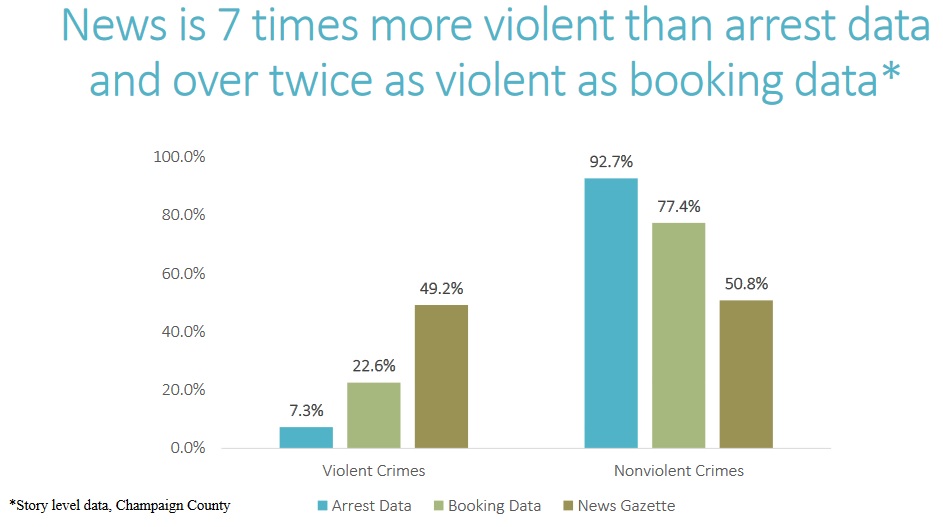There has been considerable recent discussion – and argument – over racial disparities in traffic stops. In Urbana, the findings of a “Traffic Stop Data Task Force Report” are being discussed at City Council meetings. In Champaign, a different report with similar findings has been contentious.
For some, the data is transparent, objective. Jail architect Donald Kimme argues that if African-Americans are stopped more frequently, that is because they are more often doing something wrong. For some on the opposite end of the political spectrum, cops look for Blacks to stop more frequently.
But disparities do not, ipso facto, prove discrimination.
This is why a 28-page, fall 2015 study is important. “Representation of Race and Gender in News-Gazette Crime Coverage” systematically compared all arrests and jail bookings with all crime stories between June and September, 2015. It is the first study ever to compare “the demographics of suspects in the news to the demographics of suspects arrested or jailed” for any Champaign County news outlet. Eight students supervised by a faculty member used meticulous, painstaking social science quantitative techniques to analyze three months’ data. What were the findings?
First, there were 1497 jail bookings that resulted from 5,016 arrests. Many will be surprised that over half – 57 percent — of all arrests were for traffic violations.
Second, violent crimes were reported in the News-Gazette seven times more often (49.2 percent) than those arrested (7.3 percent) for such crimes. Conversely, nonviolent crimes were only half as likely to be written up (50.8 percent), compared to the 92.7 percent arrested for such crimes.
The third finding is where it gets interesting. More whites were arrested (48.5 percent) than Blacks (39.9 percent), but more Blacks (55.6 percent) wound up booked than whites (37.7 percent). Yet you would never know it from the News-Gazette, which was more than two-and-a-half times likely to write on Black crime suspects (48.9 percent) than white suspects (18.7 percent).
This last finding is reinforced by the differential use by race of news photos, typically mug shots. “We see a clear trend in the suspect image data,” concludes the “News-Gazette Crime Coverage” study. “[W]hile the typical local crime suspect pictured in the newspaper is Black, the typical crime suspect arrested in Champaign County is white.” African-Americans made up a full 67.5 percent of suspects pictured in the news, but 55.6 percent of those booked and only 39.9 percent of those arrested. Conversely, only 30.1 percent of those pictured in news stories are white, but whites made up 37.7 percent of bookings and 48.5 percent of arrests.
The “News-Gazette Crime Coverage” study clearly demonstrates striking, statistically significant racial disparities in crime reporting. However, “the reasons for such disparities are beyond the scope of this report.” For that, remarks made recently by crime reporter Mary Schenk, one of the paper’s “stars,” to an Osher Lifelong Learning Institute (OLLI) class are revealing.
Schenk’s day begins early. First thing, she checks with her sources in local law enforcement: what’s happened in the past 12 hours? They know the kinds of stories she’s interested in. “Serious” crimes – residential crime, rape and sexual assault, gun violence. Although rare, murder, for sure. Drugs, DUIs, so long as they are out of the ordinary, such as the 30 pounds of cannabis in a courtroom that “had jurors and spectators sniffing, sneezing and coughing.” She “skips the domestic abuse usually,” considering it a private affair. Best are the too-weird-to-be-true stories. The puppy cooked alive in the oven. The guy who tortured his girlfriend’s cat.
What about the mug shots? They are the “most popular” item online. According to Schenk, the News-Gazette pays a commercial company to scrub bookings records such as the sheriff’s public website, adds ads, and leaves the mugshots up longer than the sheriff’s website. “But what about the presumption of innocence – these people have been arrested, not convicted.” Schenk’s response: “I don’t care.”
To be fair, the context here is that the News-Gazette, along with most every paper in the nation, is not doing all that well in the brave new world of digital media. For several years after the Great Recession beginning in 2008, the paper operated at a loss. It only got back in the black after some five years of belt-tightening, expanded online presence, and leadership changes. A 30-year employee, Schenk, for example, cut back her paid hours from 40 to 35 per week. She puts in considerably more time than that.
“Isn’t the paper’s approach ‘if it bleeds, it leads’?” she is asked. “What about the lurid details?” She does not reply directly. “What about the paper’s conservative political slant?” Her response, “Buy the newspaper. I don’t care if you read it.”
Economics trumps ethics. When the choice is running in the red or in the black, ethics become expendable. After all, that’s what commercial media are all about.
In reporting crime, the News-Gazette makes other troubling choices. Placement. A murder trial gets detailed front-page coverage. The story the day after when the suspect is found not guilty runs in the second section. This happened twice in less than a month in late 2015. Moreover, the paper’s definition of “crime” does not include white-collar crime. Yes, such crime is generally more difficult to investigate, yet it is arguably much more costly in dollars and cents than the usual drug deal.
The News-Gazette generally presents to its readers a feel-good image of the community, such as weekly do-gooder profiles. At the same time, however, it invites readers to troll the mug shots, voyeuristically stalk those too weird to be true, and to fear criminals. The paper unquestionably features stories on distinguished, upstanding African-Americans. But such stories are trumped by the many more stories that produce and reproduce the stereotypical Black criminal. “By stimulating and sustaining stereotyped beliefs about the connections between race and crime, this type of news coverage can also help perpetuate systemic forms of racial injustice that take root in other societal institutions,” concludes the “News-Gazette Crime Coverage” study.
Representations are social facts. I have heard more than one member of Champaign/Urbana’s privileged white elite refer to “the bad guys.” Who are the “bad guys”? I think I have answered that question.
Would we be better off without the News-Gazette? Many readers hold their nose, and read the paper for the local news, “to keep up on what is going on.” The paper, and its supporters, argue that if a national chain operated the paper, then local news would be cut substantially, and covered by less experienced and knowledgeable reporters.
But this either/or choice – a local variation of the stock neoliberal argument, “there is no other way” – comes at a price, and the price is the paper’s skewed worldview. If it bleeds, it leads. Criminal minorities. Politically-slanted news coverage.
Back to ethics. As individuals in a capitalist society, we have the choice of buying or not buying the paper, of consuming or not consuming the News-Gazette’s worldview. But is the kind of community we want to live in, the sense of community we strive to build, the same as the News-Gazette’s?
Imagine. Wake up to a paper that gives the police blotter reporting a rest. A couple of longer stories that take a step back, a longer view. A thorough analysis of the evidence for the racial disparity in traffic stops (such a story would get enough online comments to thrill ad sponsors and editors alike). A story profiling the Police Training Institute. A comparison and contrast of Champaign, Urbana, and University police department cultures. A story on cop culture, featuring the lingo, like “power rings” (donuts).
David Prochaska formerly taught colonialism and visual culture in the UI History Department



